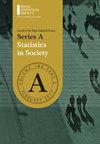Heterogeneity in the US gender wage gap
IF 1.5
3区 数学
Q2 SOCIAL SCIENCES, MATHEMATICAL METHODS
Journal of the Royal Statistical Society Series A-Statistics in Society
Pub Date : 2023-08-08
DOI:10.1093/jrsssa/qnad091
引用次数: 0
Abstract
As a measure of gender inequality, the gender wage gap has come to play an important role both in academic research and the public debate. In 2016, the majority of full-time employed women in the United States earned significantly less than comparable men. The extent to which women were affected by gender inequality in earnings, however, depended greatly on socio-economic characteristics, such as marital status or educational attainment. In this paper, we analyse data from the 2016 American Community Survey using a high-dimensional wage regression and applying double lasso to quantify heterogeneity in the gender wage gap. We find that the wage gap varied substantially across women and that the magnitude of the gap varied primarily by marital status, having children at home, race, occupation, industry, and educational attainment. These insights are helpful in designing policies that can reduce discrimination and unequal pay more effectively.美国性别工资差距的异质性
作为衡量性别不平等的一项指标,性别工资差距在学术研究和公共辩论中都扮演着重要角色。2016年,美国大多数全职女性的收入明显低于同等水平的男性。然而,妇女在多大程度上受到男女收入不平等的影响,在很大程度上取决于社会经济特征,例如婚姻状况或受教育程度。在本文中,我们使用高维工资回归分析2016年美国社区调查数据,并应用双套索量化性别工资差距的异质性。我们发现,女性之间的工资差距差异很大,而且差距的大小主要受婚姻状况、是否有孩子、种族、职业、行业和教育程度的影响。这些见解有助于制定更有效地减少歧视和不平等薪酬的政策。
本文章由计算机程序翻译,如有差异,请以英文原文为准。
求助全文
约1分钟内获得全文
求助全文
来源期刊
CiteScore
2.90
自引率
5.00%
发文量
136
审稿时长
>12 weeks
期刊介绍:
Series A (Statistics in Society) publishes high quality papers that demonstrate how statistical thinking, design and analyses play a vital role in all walks of life and benefit society in general. There is no restriction on subject-matter: any interesting, topical and revelatory applications of statistics are welcome. For example, important applications of statistical and related data science methodology in medicine, business and commerce, industry, economics and finance, education and teaching, physical and biomedical sciences, the environment, the law, government and politics, demography, psychology, sociology and sport all fall within the journal''s remit. The journal is therefore aimed at a wide statistical audience and at professional statisticians in particular. Its emphasis is on well-written and clearly reasoned quantitative approaches to problems in the real world rather than the exposition of technical detail. Thus, although the methodological basis of papers must be sound and adequately explained, methodology per se should not be the main focus of a Series A paper. Of particular interest are papers on topical or contentious statistical issues, papers which give reviews or exposés of current statistical concerns and papers which demonstrate how appropriate statistical thinking has contributed to our understanding of important substantive questions. Historical, professional and biographical contributions are also welcome, as are discussions of methods of data collection and of ethical issues, provided that all such papers have substantial statistical relevance.

 求助内容:
求助内容: 应助结果提醒方式:
应助结果提醒方式:


